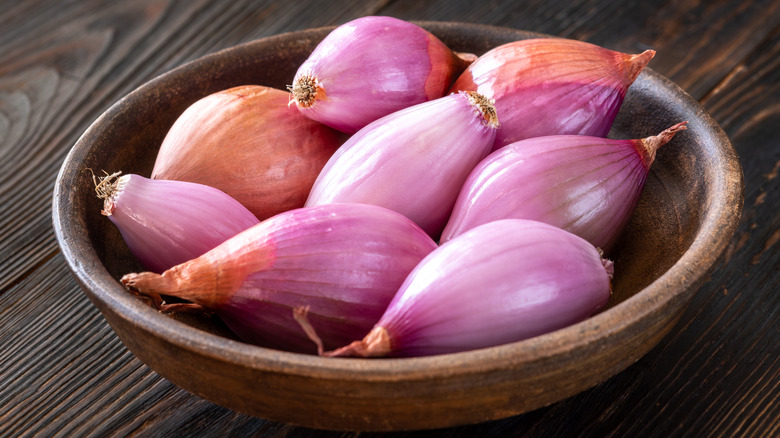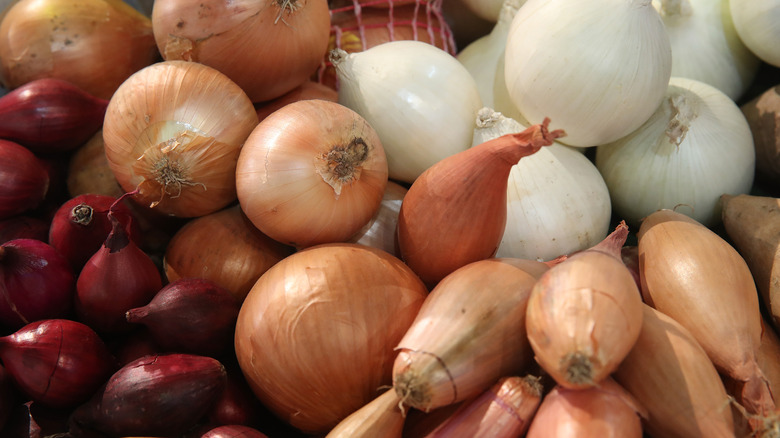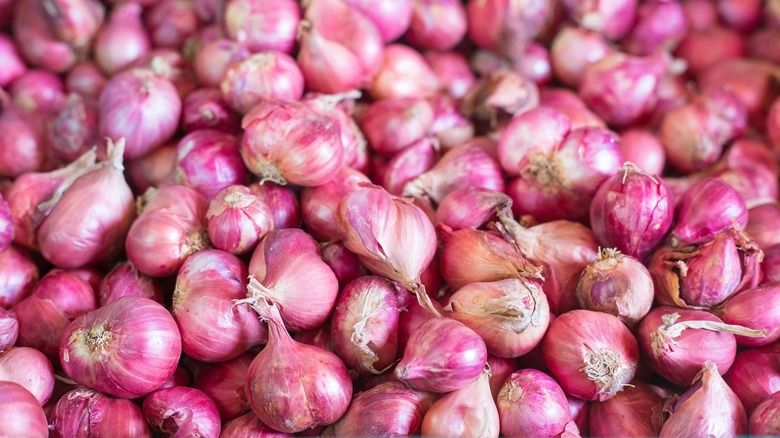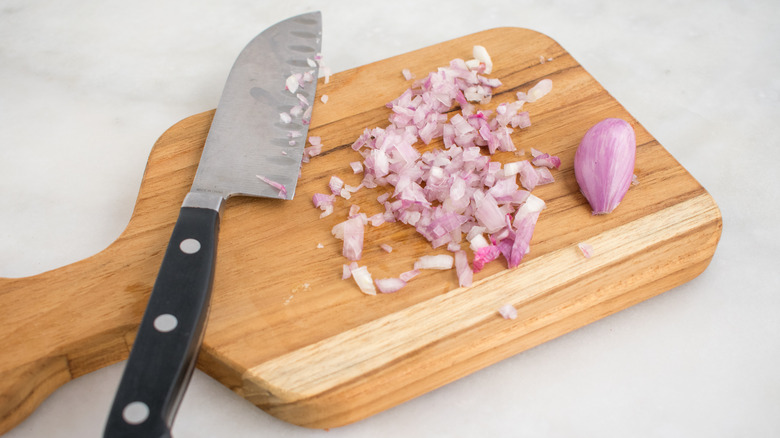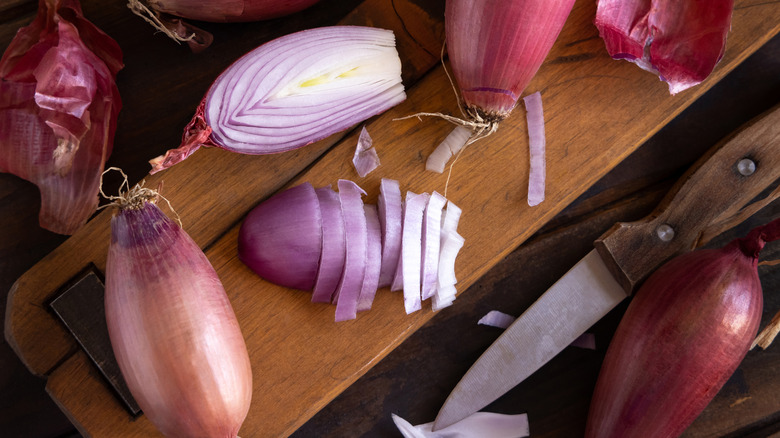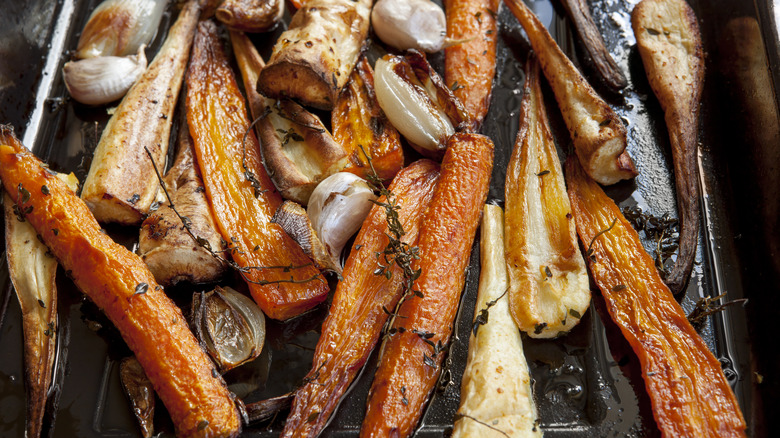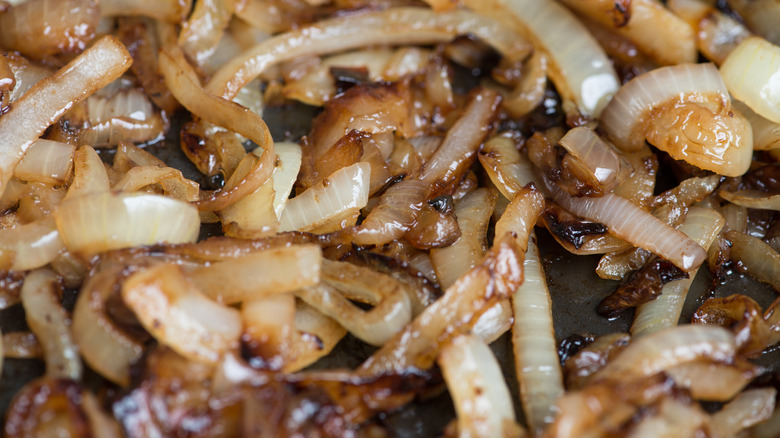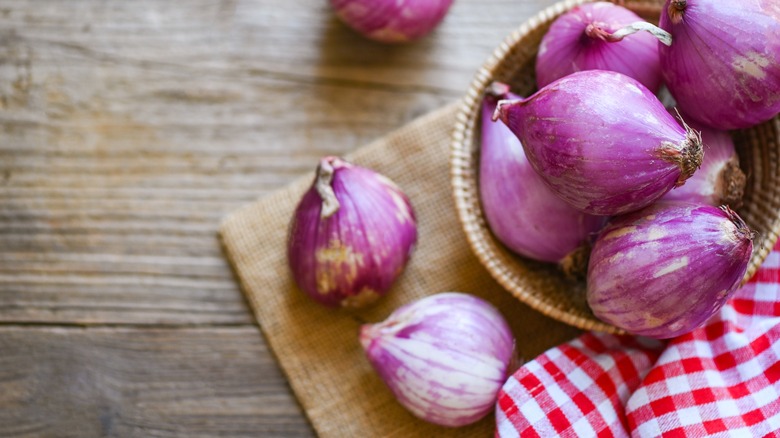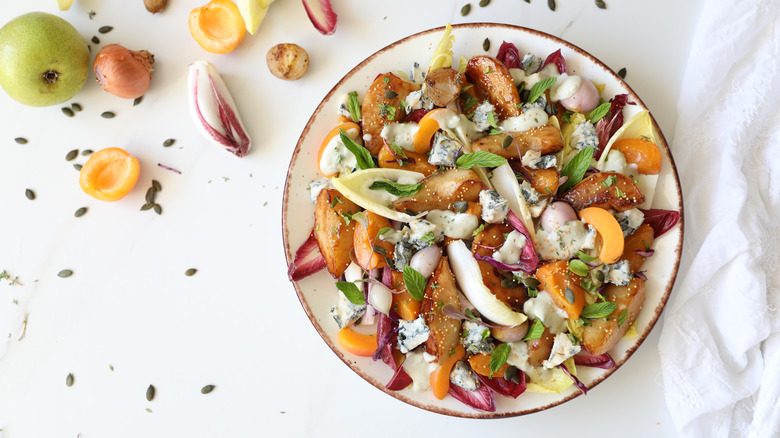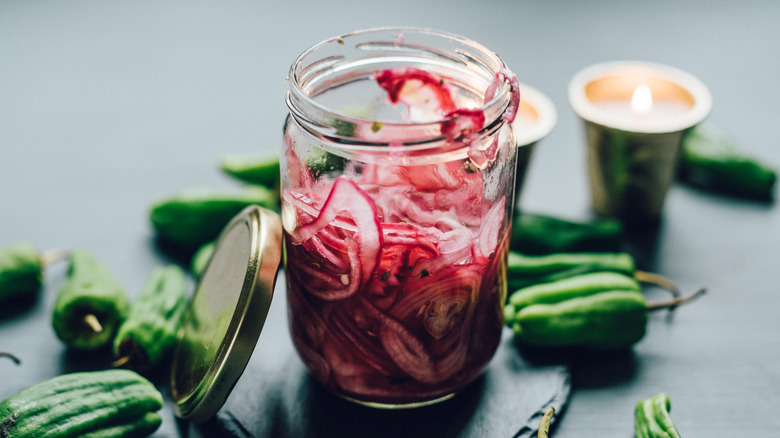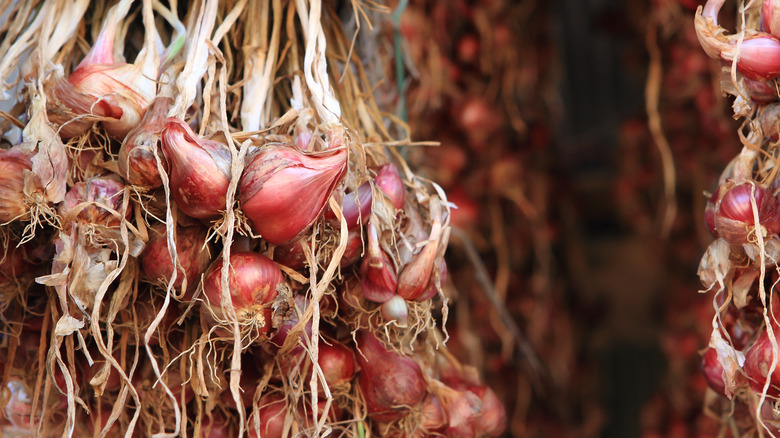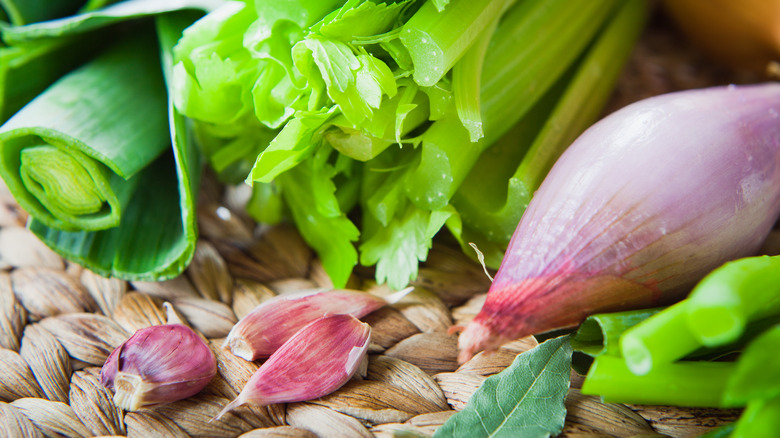Mistakes Everyone Makes With Shallots
Shallots are a fairly common sight in contemporary cooking, but many of us may still feel intimidated by them. At first glance, they seem like fancier onions, so it can feel like we should stay safely in our lane and not branch out in the allium department. Who do we think we are, Anthony Bourdain? But if you're worried about making mistakes, don't be. You're certainly not the only one intimidated by shallots, and you will be in good company when you overcome that first step. There's no reason a few worries and potential errors should keep you from enjoying these sweet, mild alliums.
Some preparation may help here. There are a range of mistakes that practically everyone makes with shallots, from chopping them incorrectly to getting their storage conditions wrong to not knowing when to use shallots and when to use onions. None of them are the end of the world, but if you want to learn how to use shallots confidently and overcome some common errors, then you're in the right place.
We're here to laugh about our mistakes and to sympathize with anyone who's made them, but we're also here to give you solutions. For each of these common pitfalls, we'll tell you how best to overcome them. So, from now on, there's no need to flip the page when you come across a recipe that uses shallots. You'll be confident cooking them and ready to embrace new flavors.
Not knowing the difference between shallots and onions
Buckle up because we're diving into the great shallot-onion conundrum. It's easy to look at a shallot and just assume it's effectively a small onion. After all, they do look similar, and they are related vegetables both in the allium family. Shallots are smaller, with a tapered shape, while onions are bigger and bulkier. The real difference comes down to flavor. Shallots are the sophisticates of the culinary world, with a flavor that's typically described as mild, sweet, and a tad peppery. They are complex in flavor, creating a taste experience that is like a cross between a sweet, mild onion and a bulb of garlic. Meanwhile, onions are more bold and can range from sweet to an eye-watering pungency.
So, how do you know which one to use and when? If you're aiming for subtlety, sophistication, and nuanced flavor, shallots are the way to go. They're especially great in vinaigrettes, delicate sauces, or a classy omelet. If you want to make a statement, turn heads, and add some oomph to your dish, that's where onions shine. It's not about one being better than the other. Rather, it's about playing to each vegetable's unique strengths. Shallots are the James Bond of the kitchen — smooth operators in refined settings. Onions? They're the rockstars that will steal the show in hearty, robust dishes.
So, the next time you're in the grocery aisle debating between these culinary siblings, remember these basic differences. Ultimately, consider whether you want subtlety or maximum flavor.
Picking old or bad shallots
It's common for people to accidentally pick up old or bad shallots at the grocery store. Shallots are a little more delicate than onions and are less commonly used, so they might have been hanging around the store for longer. You may not also be familiar with what a good shallot looks like. We've all been there: thinking we struck gold in the produce aisle, only to find out we just bought some duds. It's a shame to fall at the first hurdle, so how do you pick perfect shallots?
First off, consider the appearance. Look for shallots that appear firm and have tight, papery skin. Avoid ones with spots or green sprouts emerging from the top. Next, give a shallot a gentle squeeze — nothing too aggressive. A fresh shallot should feel solid, not mushy. If it yields under the pressure of your touch like a deflated balloon, sorry, but you've got a bad shallot on your hands. It should also feel heavy for its size. If it feels light, it may have lost moisture and be past its prime.
Finally, you may want to also run the smell test. Fresh shallots should have a mild, slightly sweet aroma. If it smells funky, like it's been sitting in the back of your fridge for too long, it's time to part ways. Don't let those sneaky bad shallots infiltrate your kitchen. Pick wisely so your culinary adventures are filled with only the freshest, most vibrant offerings.
Always cooking shallots rather than eating them raw
Hold onto your chef's hat because we're about to venture into the uncharted (for some) territory of raw shallots. Frankly, it's a bit of a crime not to explore them in their raw, unadulterated glory. While many make the mistake of relegating shallots to the sizzling pan, let's break free from the culinary norm and celebrate the crunch, bite, and fresh zing of raw shallots.
For instance, you'll surely enjoy a crisp, refreshing salad that's not just a symphony of greens but also boasts the sharp, oniony kick of raw shallots. Simply toss them with some mixed greens, cherry tomatoes, and a tangy vinaigrette, and you'll wonder why you ever bothered cooking them. But we're not stopping at salads. No way! Elevate your sandwich game by adding thin slices of raw shallots. Suddenly, that humble sammie becomes a flavor-packed meal.
Ultimately, you can use raw shallots anywhere that you would use raw onions. The beauty here is that you can also use them in dishes where you like the idea of using raw onion but may find them too sharp or overwhelming. Thanks to the less intense flavor profile of shallots, they're perfect for occasions when you find onion will be a bit too much or you want to avoid onion breath.
Chopping them incorrectly
Chopping shallots is a task that's often underestimated and, unfortunately, gets botched more times than we'd care to admit. It's time to set the record straight and, in so doing, ensure that you chop those shallots like a pro. For starters, let's address the shallot's dual-lobed nature. Many cooks fall into the trap of treating it like a small onion, meaning they peel the veggie's skin and start hacking away. Mistake alert! The trick here is to recognize that shallots often come with multiple lobes. Treat them individually — that is, chop each one separately — for more precise and even results.
When it comes to the actual chopping, you have plenty of options. If you want julienned shallots, slice each one lengthwise to maintain the natural lines of the lobes. Before you're done, remember to chop off the root. If you want diced shallots, start in the same way, with lengthwise cuts. Then, simply rotate it 90 degrees and make perpendicular cuts. Take your time, and the resulting pieces will be neat and uniform. You can also make rings by simply slicing your shallot widthwise across the lobe.
Not roasting them whole
Listen up: if you haven't thrown whole shallots into the oven to roast, you're missing out. Roasting whole shallots is like discovering the secret backstage pass to culinary bliss — and let us tell you, the party is epic.
Here's how it goes down. Once you pop those little shallot bulbs into the oven to roast, magic happens. The heat transforms the natural sugars inside the shallots, caramelizing them and making the vegetables even sweeter. What's even better about roasting whole shallots is the simplicity of the process. No fancy knife skills are required, and there are no intricate recipes to follow. Instead, just toss them onto a baking sheet, drizzle with a bit of oil, and let the oven do its thing. The result? Golden-brown perfection with a melt-in-your-mouth texture that's all but impossible to turn down.
Whole roasted shallots are kitchen chameleons that you never knew you needed. Blend them into creamy mashed potatoes for an extra layer of richness. Toss them into salads for a flavor boost that'll have you questioning your old salad game. Or, scatter them on a pizza for a sweet surprise that turns a regular pie into a gourmet masterpiece. You can make shallots even tastier by roasting them with fresh herbs, such as thyme and rosemary, or some garlic for a real allium party. You can also keep things simple and roast them in a tray with other veggies to lend more flavor to your meal.
Cooking them at too high a temperature when caramelizing
Caramelizing shallots isn't as simple as it seems, as you need to take care to get the temperature just right. Too low, and you will be stuck with limp, pale shallots. Too high, and you've entered the danger zone of burnt bitterness. It's a mistake we've all made at one time or another: cranking up the heat, thinking we're accelerating the flavor train, only to derail it instead.
Here's the golden rule of shallot caramelization: low and slow. Think of it as a leisurely stroll through the flavor park rather than a sprint. High temperatures might seem like a shortcut to caramelized bliss, but they only lead to disappointment. Why the caution? Well, shallots are delicate beings. They've got natural sugars that need coaxing, not scorching. A low temperature allows those sugars to gradually break down, transforming into the sweet, golden ambrosia we crave. The sweet spot for shallot caramelization is somewhere between patience and precision. Medium-low heat is your ally, being just enough to coax out those sugars without turning your shallots into bitter, blackened casualties.
So, the next time you're tempted to crank up the heat, resist the urge. Keep the burner at medium-low and learn to wait. Your patience will be rewarded with perfectly caramelized shallots that you can use as the base for a range of dishes or as a tasty topping.
Using too few shallots
You might start with what seems like a decent pile of shallots, toss them into the sauté pan, and then — poof! Like a culinary magic trick, they shrink into tiny versions of their former selves. If you've ever underestimated the quantity of shallots you need, you're not alone. It's a common misstep that's all about misunderstanding how shallots behave when cooked.
The mistake here is thinking that the quantity you start with will be the quantity you end up with. Shallots reduce in size dramatically when they are sautéed. So, to keep up, you've got to be bold. When the recipe calls for shallots, don't be stingy. Because they get so much smaller in the pan, make sure you start with enough, or you'll be left disappointed down the line. Either you'll have to waste time cooking more, or you'll be left with a dish without enough allium flavor.
It's not just about mass, either. Whether you're crafting a delicate sauce, a hearty stew, or a sizzling stir-fry, having an ample supply of shallots ensures that their flavor doesn't get lost in the cooking shuffle. Think of it as buying insurance against blandness. Getting the shallot quantity right is a culinary safety net that guarantees your dish won't fall flat. It's quite hard to overdo it with relatively mild shallots, so load up on them and embrace flavor.
Not using them in dressings
If you've been wanting to elevate your salad game, there's a simple solution waiting in the wings: shallots. For anyone who's been neglecting these tiny flavor powerhouses in their dressings, it's time for a salad revolution. Like they do in so many other dishes, shallots bring a subtle yet transformative touch to salad dressings. Their mild, sweet onion flavor adds depth without the overpowering punch you might get from regular onions.
The key to incorporating shallots into dressings is finesse. Don't just throw them in willy-nilly. Instead, treat shallots with the respect they deserve. First, be sure to mince or grate them finely. This ensures their flavor disperses evenly, becoming one with your vinaigrette. But it's not just about flavor. Shallots bring texture to the party, too, adding a delightful crunch.
Now, let's talk about versatility. Shallot-infused dressings are the little black dresses of the culinary world — they go with everything. A classic vinaigrette with minced shallots can turn a simple green salad into a gourmet affair. Or, you might whisk them into a creamy dressing for a potato salad that will steal the picnic spotlight. Feeling adventurous? How about a honey-shallot dressing drizzled over a grilled peach and arugula salad? Yes, please!
So, next time you're whipping up a dressing, don't overlook shallots. If they aren't in your regular salad dressing rotation, they should be. It's the dressing revolution you never knew you needed, one shallot at a time.
Not trying them pickled
Take a walk on the tangy side with pickled shallots. If you haven't ventured into pickled shallot territory, consider this your invitation. It's an oversight, but one that is not too late to rectify. Pickled shallots are bold, zesty, and unmissable. What makes them a true game-changer? That would be the contrast between the mild flavor of shallots and the acidic zing of the pickling liquid. It's like a pickled onion went for a walk and mellowed out into something delightful.
What's especially great about pickled shallots is how they effortlessly elevate a range of dishes. Toss them into salads for a burst of acidity that cuts through the greens. Plop a few onto your sandwiches or burgers to add a unique punch. Pile them atop tacos for a milder alternative to pickled red onions. Feeling fancy? Pair them with charcuterie or cheese boards for a twist that'll impress even the pickiest food critics.
What sets pickled shallots apart from the competition is their ability to play both sidekick and star. They can complement a dish with their tangy undertones or take center stage, showcasing their bold personality. It's like having a versatile condiment that's ready to steal the spotlight or play a supporting role, depending on the culinary scene you're engaging in. So, if you're not on the pickled shallot bandwagon, it's time to hop aboard. You won't regret taking a ride.
Storing them incorrectly
Incorrect storage can lead to sad, shriveled shallots that make for an unpleasant surprise at the bottom of your vegetable drawer. If you're guilty of tossing them in haphazardly and hoping for the best, then we must gently let you know that it's time for a storage intervention. If it makes you feel any better, this is another common mistake that's easily rectified. Once you learn to store shallots properly, you'll be able to keep them fresh for ages.
In short, shallots demand a cool, dry, and well-ventilated environment. The mistake many foodies make is treating them like other veggies in the fridge and tossing them into the crisper drawer. Big mistake! Shallots prefer a quiet, secluded spot away from the thick of things. The ideal storage spot for shallots is a cool, dark pantry or a mesh bag that's hung in a well-ventilated area. This keeps them from sprouting or getting soft and mushy
But what about shelf life? Well, when stored correctly, shallots will be at your disposal for a seriously extended period. They can last for a couple of months, depending on the conditions. Check them periodically, and if you notice any sprouting or softening, it's time to bid them a fond farewell.
Not knowing how best to substitute them
Let's demystify the shallot substitution game, where many home cooks find themselves at a crossroads. When you don't have shallots at hand and need an alternative, the knee-jerk reaction is often to reach for the reliable onion, thinking it's a one-size-fits-all swap. Sure, onions seem like the logical shallot stand-in, but here's the kicker: they're not always the best choice. Shallots bring a subtlety and mild sweetness that more powerful onions can't quite mimic. It's like swapping a whisper for a shout. So, if your recipe is yearning for that delicate, nuanced touch, think twice before grabbing an onion and starting to dice.
When you're aiming for a particularly mild and sweet flavor, leeks step up to the plate with finesse. Picture them as the shallot's taller, greener cousin, ready to add a touch of elegance to your dish. Slice them thinly for a texture that is reminiscent of shallots, and watch as your recipe gets a flavor upgrade. But, a word of caution: leeks can be a bit milder than shallots, so adjust quantities accordingly. If your recipe calls for minced shallots aim for a similar volume of finely chopped leeks.
The beauty of the shallot substitution game is the chance to experiment. Don't be afraid to get creative — scallions, chives, or even garlic can step in, depending on the flavor you're after. So, the next time you're out of shallots, resist the urge to default to onions without a second thought.
